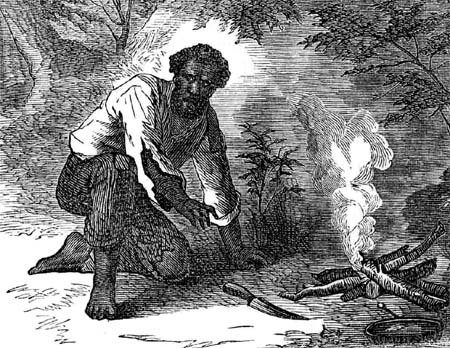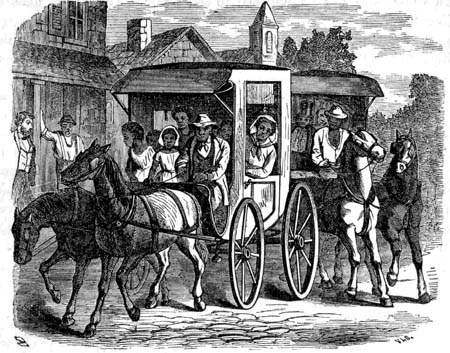|
FRESH STUFF DAILY |
|
|
||
|
|
||
|
|
||
|
SEE ALL SIGNED BOOKS by J. Dennis Robinson click here |
||
Page 2 of 3
Fleeing from slavery on foot -- starving, scared and hunted -- Ernest reminds us, was "a journey of biblical proportions". Slaves had to travel enormous distances just to reach the northern outposts of the underground support system in Philadelphia, for example, making the treacherous southern leg of the sojourn alone. And the "freedom" blacks met upon reaching the fabled land of equality in Canada and the northern US, still contained a level of racism and discrimination intolerable today. Mystery fuels the Underground RR. Its secrecy served a dual purpose, first by protecting the identities of those in the escape network, white and black. Secondly, black abolitionists like Frederick Douglass wanted southern slave owners to believe in an extensive, organized, well-funded popular network of "slave stealers". The more they feared the Underground Railroad, Douglass reasoned, the better. In one of his three autobiographies, Douglass wrote that the southern slave owner should live in fear of "having his hot brains dashed out by an invisible agency." The less he said about the Underground Railroad, the more the legends grew. How New Hampshire fit into this escape map is the focus of further research. Jody Fernald, a co-sponsor of the conference, presented her case for an Underground RR station in Lee, NH. Fernald has identified the Cartland house there, still privately owned. She has begun the extensive work of documenting the efforts of the Quaker family who lived there and were members of a "vigilance committee" that aided fugitive slaves. Fernald’s evidence focuses on the escape of Oliver Gilbert, an enslaved black who left Maryland in 1848 at the age of 16. Authenticating the Lee site means tracking Gilbert’s trail possibly from Newbury, MA, through Kensington, to Lee and beyond. While in Lee, under the protection of Moses Cartland, Gilbert may have done farm work and built a stone wall. Anna and Phoebe Cartland may have taught him to read. The Gilbert itinerary leads back to Boston where the fugitive spoke to white abolitionist groups, then off to New York in the 1850s where he married and had six children. Gilbert lived a rough and tumble life and turned up as a musician in Philadelphia during the Civil War. He made a pilgrimage back to Lee, NH in 1902. Fernald remains on the trail, accumulating data, making her case. No one intends to diminish the struggle of white abolitionist in the decades-long battle to end American slavery. The Cartlands, for example, suffered condemnation from their Quaker elders. White abolitionist were arrested, mobbed, stoned, jailed, reviled, branded with a hot iron, and even killed. But their brave stories inevitably pale against the daily lives of the enslaved blacks. While thousands escaped, four million African-Americans remained enslaved in the South in the mid-1800s.
The fear, according to one conferee, is to avoid creating "Underground Railroadland", turning the history of racial struggle into a theme park. By authorizing "official" black history sites, the federal government is working hard to put together a jigsaw puzzle of an organization that never actually existed. The freeze-dried official synopsis may take us down a sidetrack. Will Underground Railroad web sites, texts, videos, guides and board games inspire children to learn more about what Douglass called "American Slavery"? Or will it provide only easy answers and a national treasure hunt for secret stairways and hidden tunnels? Debbie Khadraoui is a seventh generation African-American whose family settled in Bath, ME in 1754. With Wells Staley-Mays and others, she has devoted the last few years to reconstructing the Abyssinian Baptist Church in Portland. It is the oldest standing African-American church in the United States. But authenticating an Underground Railroad site, she says, requires one thing -- "studies, studies and more studies." But there is a benefit to this exhausting research, and perhaps to the promise of government funding and the income derived from cultural tourism. The more we study, the more we learn. What we learn in Portland, according to Staley-Mays, is that Maine had a "freed" black population of 600 at this time. Portland was, after all, based on a rum economy, and many blacks served as mariners and dockyard workers. Others were typically barbers, hack or carriage drivers and used-clothing salesmen. It’s an odd combination of occupations, he says, unless you consider the kinds of jobs that might be useful in smuggling, transporting, and disguising fugitive slaves. The facts are, not only did most escaped slaves make their own way out of the South, but most northern aid came from fellow blacks. There were white abolitionist engineers and conductors to be sure, like William Lloyd Garrison, but the workers on the Underground Railroad, by in large, were African-Americans -- and white women – who closely identified with their struggle for freedom. That is the picture we need to capture in our imaginations, a picture not often found in American history textbooks or on national monument plaques. The Underground Railroad is built, not out of steel, but of iron-willed people – black and white. And when it finally pulls into New Hampshire again, our true job is to climb aboard and follow the stories back to the heart of slavery, where so many of America’s modern troubles began. Copyright © 2006 by J. Dennis Robinson. Robinson is editor of SeacoastNH.com and a trustee of the Portsmouth Black Heritage Trail. All rights reserved. This piece originally appeared here in another form in 2000. Images from William Stills (1897) "The Underground Railroad: A Record of Facts, Authentic Narratives, Letters" available online from the Library of Congress "American Memory" web site. READER RESPONSE TO UNDERGROUND RAILROAD Please visit these SeacoastNH.com ad partners.
News about Portsmouth from Fosters.com |
| Friday, April 26, 2024 |


|
Copyright ® 1996-2020 SeacoastNH.com. All rights reserved. Privacy Statement
Site maintained by ad-cetera graphics

 Stories
Stories




















